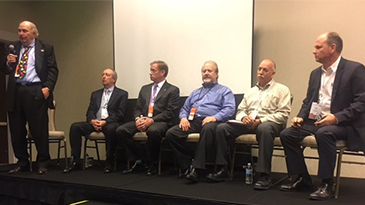The upstream industry’s drive toward standardized designs is changing economics for asset development. In a public presentation made at the AspenTech-sponsored OPTIMIZE™ 2017 conference, ExxonMobil described their application of standardized design for LNG assets, leading to reduction in time, risk and, most importantly, CAPEX — in excess of 50 percent. This constitutes a major digital transformation opportunity for upstream companies.
Of course, the idea of standardized design is not new. Dow Chemical, as one example, has long believed in the benefits of global standardization across all of its chemical assets. As Vice President of Manufacturing and Engineering Bob Brandt explained in his keynote presentation at EMET 2016 in Bahrain, it is only through standardization that an organization can effectively learn from itself and continuously improve. A singular result or improvement implemented at one site can easily be adopted by sister sites, if they are all employing standardized designs as well as the associated technology systems that enable their optimized operation.
Standardized design for upstream should be easier and more powerful than similar concepts in chemical manufacturing. In principal, the processes are proven and well-known. One-of-a-kind designs should not be necessary. This should drive continuous improvement in these designs, as well as removing the tendency to design each instance of an asset from the blank paper up.
Contrarians point out that each crude profile is different, and therefore the best field yields come from one-of-a-kind designs. However, upstream executives have been directing for that past three years that their organizations drive toward standardized designs.
Here are some of the benefits industry innovators are expecting from the use of standardized design in developing upstream asset production and processing infrastructure:
- Reduced front-end and FEED design time and hours. By taking an off-the-shelf, known design instead of starting over, at least one owner reports cost savings of 50 percent and time savings of 75 percent in this activity. The prerequisite for this is having the right software technology infrastructure that can capture the process design and its associated CAPEX and OPEX parameters. The right software technology can take these libraries of best-case designs and accurately scale the designs for size, application and location.
- Reduced project risk. By using already executed designs, as-delivered costs are known. Therefore the risk of significant cost overruns or of redesign midstream are very significantly diminished.
- Reduced financial risk. The ability to finance and insure projects is improved — and costs are reduced — when the design is proven and the overall uncertainty envelope is lowered.
- Agility and speed in reacting to a changing marketplace. Especially when combined with modular construction, but even when that isn’t considered, this approach enables shorter cycle times and, therefore, enhanced ability to react to changing business objectives more quickly.
- Overall improved time to first oil. Within the environment of minimizing CAPEX and OPEX, one of my key contacts at one of the largest upstream companies told me that, above all, time to asset production is still the most important driving imperative in the upstream business. Use of standardized design definitely supports that.
- Optimizing the asset over the lifecycle and over an enterprise’s entire system. When multiple assets are executed with similar designs, technology and equipment, operational excellence lessons from one asset can be much more easily transferred and applied in sister assets. Still today, a surprising number of upstream companies operate each major asset as a separate “geo region,” using methods and approaches independently rather than learning about best practices across the enterprise.
In April, 2017, an industry panel of project cost engineering experts talked about the rapid changes happening in the industry, and how they affect projects that will be executed in the future. A key opportunity is to use the best-performing designs as the basis for the “next design,” as I’ve just explained. Another key benefit that arises from this, though, is better collaboration and partnering between the owners and contractors and designers. That is the core of what this panel discussed.
So the same underlying software technologies that empower an upstream company to achieve standardized design also provide a powerful digital mechanism to break down the wall between the estimators at EPCs and the capital asset project managers at the owner. Read my earlier blog post for more details on this important business transformation opportunity.
So what are the digital technology elements that enable standardized design and collaboration across the asset lifecycle? These are some of the key enablers that AspenTech has innovated and developed:
-
Process modeling tools. Aspen HYSYS® has evolved from being a process simulator to being a process engineering toolkit. In particular, the unification of multiple technical modeling tools enables the optimization of designs across multiple objectives, such as sustainability, energy use, throughput and crude flexibility. But especially, it unlocks the ability to capture best practice designs as “templates,” which can easily be treated as building blocks for new designs.
-
Cost estimating modeling. Aspen Capital Cost Estimator™ (ACCE) is the only process-industry estimating tool that can achieve accurate cost forecasts with 10 percent or less of engineering completed. Further, the ACCE system empowers the capture of as-built costs as building-block templates, and it also provides power modular construction optioneering.
-
The patented “activation” automation of knowledge work. Through this approach, rigorous costing, heat exchanger, energy and dynamic models are encapsulated and integrated into the Aspen HYSYS toolkit, enabling optimization over multiple parameters, and democratizing specialized modeling tools for broad access across an organization.
To learn more about how standardized design is a key element of digitalization of the upstream business, read our white paper Beyond Oil Digitalization: The Roadmap to Upstream Profitability.
For more information on the ExxonMobil presentation from OPTIMIZE 2017, contact me at ron.beck@aspentech.com.





Leave A Comment